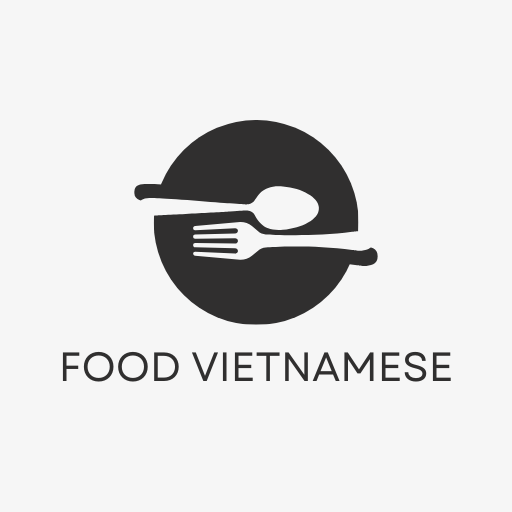Although not well-known among international friends, bánh canh giò heo (Vietnamese pork hock noodle soup) is a favorite among Vietnamese people due to its rich flavor, chewy noodles, and deliciously fatty pork hock. This article will provide you with a recipe to cook a traditional and flavorful bánh canh giò heo.
A very distinctive dish in Southern Vietnam, bánh canh giò heo is often modified by home cooks, who adjust the seasoning and accompanying ingredients. Regardless of the variations, the dish always maintains its delicate sweetness thanks to the broth made from pork bones, and the chewy noodles that are very appetizing. Here, Food Vietnamese shares the ingredients and cooking method for bánh canh giò heo so you can add a nutritious dish to your family’s menu.
Ingredients for cooking bánh canh giò heo
The following ingredients are enough to make a pot of bánh canh giò heo for 4 people:
- 500g pork bones
- 1 pork hock
- 500g bánh canh rice noodles or tapioca noodles, depending on preference
- 3 carrots
- 30g fresh herbs including lettuce, bean sprouts, and basil
- 10g ground pepper
- 10g scallions
- 10g shallots
- 5g fresh chili
- 10g seasoning including sugar, salt, bouillon powder, and MSG.
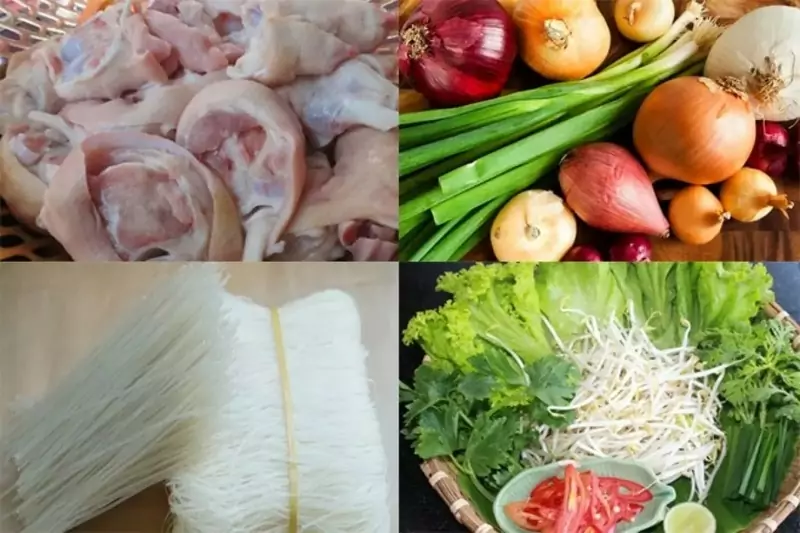
Detailed Instructions for Cooking Bánh Canh Giò Heo
Once you have prepared all the ingredients, follow these steps:
Preparation of Ingredients
- Wash the carrots thoroughly, cut into pieces about 2cm thick, and carve them into flower shapes if desired.
- Chop the scallions finely.
- Wash the fresh herbs and greens, soak them in dilute saltwater for about 10 minutes to remove any pesticide residues, then drain.
- Slice the fresh chili.
- Peel the shallots and roast them over a flame to release their aroma.
- Clean the pork bones, blanch them in boiling water, then rinse them under clean water, and drain.
- Scrape off the hairs and clean the pork hock, cut it into pieces about 5cm long, blanch in boiling water, then rinse under clean water, and drain.
Cooking the Broth
- Place a pot on the stove, add 1 liter of water, and bring it to a boil. Add the blanched pork bones and 2 roasted shallots, and simmer over medium heat for an additional 20 minutes.
- Add the pork hock and cook until it is tender. During the simmering process, avoid covering the pot to keep the broth clear. Skim off any foam that rises to the surface.
- When the pork hock is nearly cooked to your desired tenderness, add the carrot pieces.
- Once the pork hock and carrots are fully cooked, season the broth with sugar, salt, MSG, and bouillon powder to taste.
- Add the chopped scallions and turn off the heat.
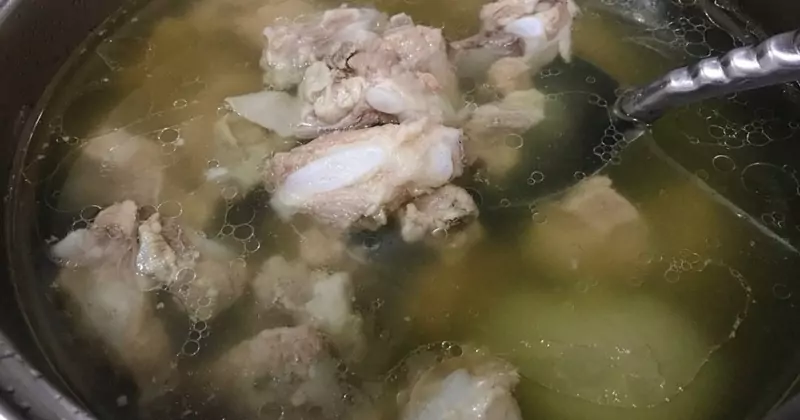
Blanching the Noodles
- Bring a pot with approximately 500ml of water to a boil.
- Add the noodles to the pot and let it boil for about 3 minutes.
- Drain the noodles in a colander and let them dry.
Final Dish
Place the blanched noodles into a bowl, scoop the pork hock on top, and arrange the fresh herbs over the surface of the bowl. Sprinkle with some chopped scallions. Finally, pour the broth into the bowl and enjoy. Bánh canh giò heo can be served with chili and lime, and the pork hock can be dipped in fish sauce with chili to enhance the flavor.
By following this recipe for bánh canh giò heo, you will have bowls of noodles with a delicious and appealing flavor. The soft, chewy noodles combined with the tender, fragrant pork hock and the broth made from simmered pork bones create a delicately sweet and incredibly appealing flavor. This dish is best enjoyed hot and should be consumed on the same day to ensure quality and nutrition.
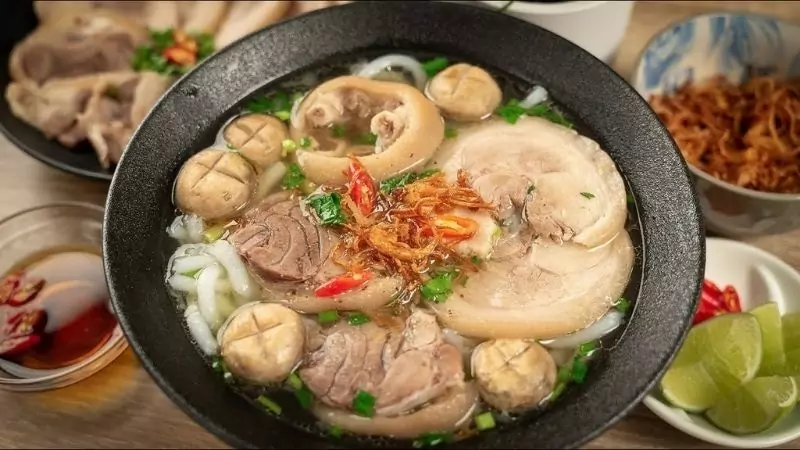
Tips for Selecting Pork Hock for Bánh Canh
The deliciousness and full flavor of bánh canh largely depend on how you select the pork hock. Choosing quality pork hock will enhance the overall taste of the dish. Here are some tips for selecting a good pork hock:
- Choose pork hocks with firm, evenly textured meat. The cut surface should be dry, and when pressed with your finger, the meat should feel elastic.
- Opt for pork hocks that are a fresh pink color, with no unusual colors. The cut surface should look bright, natural, and dry.
- The pork hock should not have a foul odor or any unusual particles.
- If your family prefers more tendons, you can choose the front hock, as the rear hock has less meat and fat due to the pig’s limited movement.
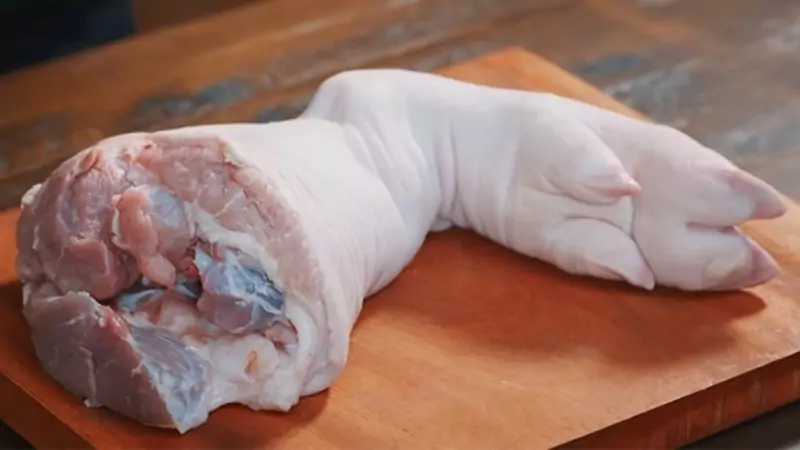
Does Eating Bánh Canh Cause Weight Gain?
For those on a diet or maintaining a controlled eating regimen, the calorie content of a dish is an important consideration. Bánh canh, made from rice flour, contains starch. However, the starch content is not too high, making it an ideal choice if you are trying to lose weight while still enjoying a delicious and nutritious meal.
A bowl of bánh canh giò heo provides approximately 350 – 400 calories. On average, a person needs to consume 2000 calories per day, equivalent to about 667 calories per meal if eating three main meals a day. Thus, eating one bowl of bánh canh for any main meal will not cause weight gain.
Additionally, bánh canh is a broth-based dish, which helps you feel full for longer and reduces the tendency to snack. This advantage, combined with its relatively low-calorie content, means you can enjoy bánh canh without worrying about gaining weight or becoming obese. If you are still concerned, you can combine it with light exercise about an hour after eating to maintain a stable weight.
There are various types of bánh canh, such as bánh canh ghẹ (crab), bánh canh mọc (pork ball), bánh canh cua (crab), and bánh canh cá lóc (snakehead fish), but the most popular is still bánh canh giò heo. Hopefully, the above tips have helped you understand the ingredients and how to cook traditional Vietnamese bánh canh giò heo. Visit the Foodvietnamese website daily for more delicious recipes from the rich culinary culture of Vietnam!
